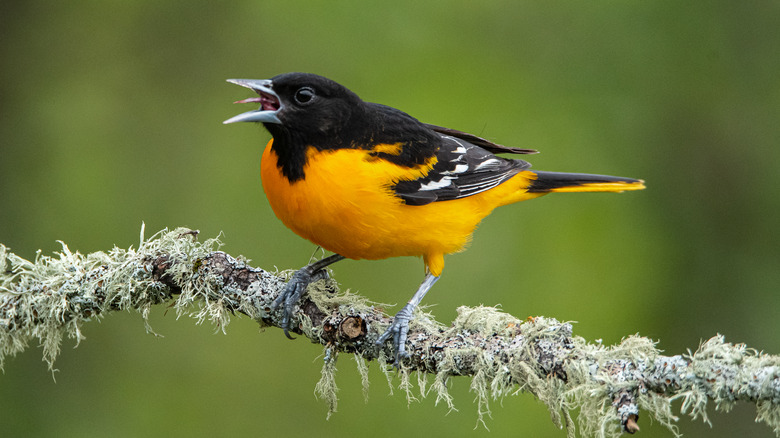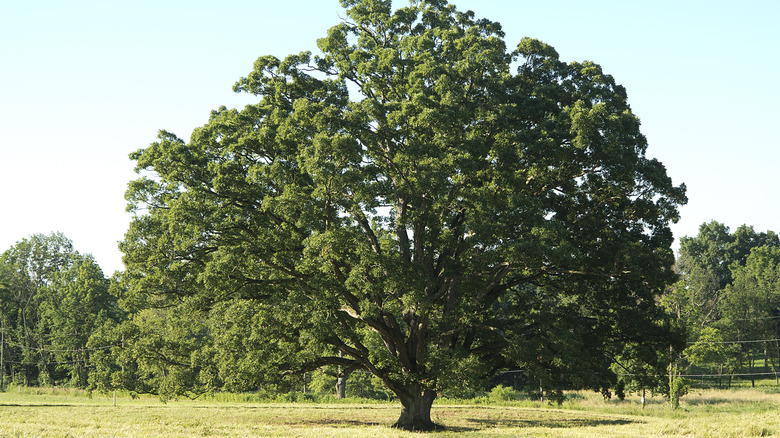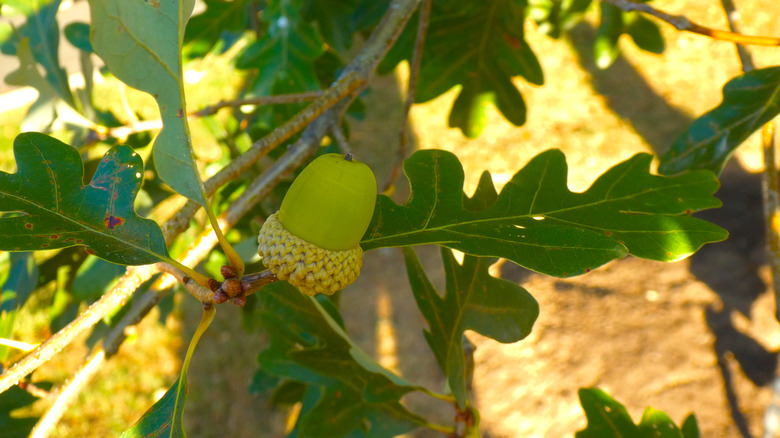Grow This Gorgeous Tree To Bring Beautiful Songbirds To Your Yard
When it comes to avian accommodations, the white oak tree (Quercus alba) is an all-inclusive resort. With plenty of private perches, luxury nesting accommodations, and an all-you-can-eat insect buffet, it's a spectacular songbird sanctuary. These multifaceted trees are commonly found in wild woodland areas, but like many other types of oak trees, they grow great in backyards. If you're in the market for a songbird bed-and-breakfast, the white oak might be the investment opportunity you've been looking for. But you'll need loads of space and lots of patience. Like many investments, this one may take a while to pay off.
The white oak (sometimes called the northern white oak or eastern white oak) is a large deciduous tree native to the eastern United States and southern Canada. Named for its whitish gray bark, this mighty tree reaches heights of 80-100 feet and often lives more than 300 years. Its widespread branches are covered with dark green, lobed leaves that turn shades of orangish brown to reddish purple in the fall. A real-life giving tree, the white oak supports hundreds of other organisms including fungi, mammals, birds, and insects, many of which feast on the oak's acorns. A single tree can produce thousands of acorns per season and more than 3 million in its lifetime.
Why songbirds love white oak trees
Like many vacation destinations, the white oak's busy season peaks in spring and summer with the arrival of all kinds of beautiful butterflies and moths. White oaks host hundreds of species of caterpillars, which make tasty treats for vireos, tanagers, orioles, chickadees, cardinals, and other breeding songbirds. Thousands of caterpillars can live on a single tree, so there's plenty of food to go around. But caterpillars aren't the only bugs on the menu. Aphids, walking sticks, sawflies, leafhoppers, and many other insects round out this songbird smorgasbord. The white oak's widespread branches and dense foliage also provide great nesting locations for many songbirds, and mature trees attract cavity nesters like bluebirds and tufted titmice.
Blue jays routinely show up in the fall to feast on acorns, which they also cache to eat throughout the winter. Thanks to their special cheek pouches, they can carry up to five acorns at a time, and they fly more than a mile away to bury the nuts in the ground. These caches are key to the dispersal and germination of oak trees. Blue jays bury up to 5,000 acorns a year, but they don't remember the locations of all their caches. Sometimes the acorns they leave behind grow into trees. Plenty of other birds take advantage of the oak's acorns including woodpeckers, quail, ducks, and turkeys. With so many nuts ending up in birds' bellies, it's no wonder only one in 10,000 acorns becomes an oak tree.
How to grow white oak trees
Growing a white oak is a long-term investment. Because they have deep taproots, these trees are tough to transplant once they become established. This means you'll need to start with a young tree or sapling. Fortunately, white oak trees are easy to grow and care for. They prefer full sun and well-drained acidic to neutral soil. Regular mulching and adequate water are most important during early growth stages, but white oaks are fairly drought tolerant once they are established. Pruning every 2-3 years during the dormant season helps prevent disease. White oaks grow about a foot per year, but their growth slows as they mature. It takes about 20 years for the trees to start producing acorns. White oaks are sometimes tough to find in retail stores, but they can be purchased from native plant nurseries.
These stoic trees aren't too bothered by pests and diseases. While aphids, gypsy moths, oak leaf caterpillars, and other insects inhabit the trees, these pests rarely cause significant damage. Anthracnose, a fungal infection that causes brown blotches on leaves, may occur in periods of prolonged rain. The University of Georgia provides a handy guide for diagnosing common oak tree ailments. nIt may take a decade or two before your oak tree resort reaches full capacity. But even young oaks host many insects, so it won't be long before your first songbird visitors arrive. With some patience, your yard will one day become a top avian vacation destination.


